radio GMC YUKON DENALI 2003 Owners Manual
[x] Cancel search | Manufacturer: GMC, Model Year: 2003, Model line: YUKON DENALI, Model: GMC YUKON DENALI 2003Pages: 447, PDF Size: 21.97 MB
Page 99 of 447

Your vehicle has one
double-sided key for the
ignition, all door locks
and liftgate.
If you ever lose your keys, your dealer will be able to
assist you with obtaining replacements.
In an emergency contact roadside assistance. See
Roadside Assistance Program on page
7-5.
If you ever lock your keys in your vehicle, you may be
able to have your doors unlocked automatically with the
Onstar@ system
if you have an active Onstar@
subscription. For more information see OnStap System
on page
2-36.
Remote Keyless Entry System
Your keyless entry system operates on a radio
frequency subject
to Federal Communications
Commission
(FCC) Rules and with Industry Canada.
This device complies with Part
15 of the FCC Rules.
Operation is subject
to the following two conditions:
1. This device may not cause interference, and
2. This device must accept any interference received,
including interference that may cause undesired
operation of the device.
This device complies with
RSS-210 of Industry Canada.
Operation is subject
to the following two conditions:
1. This device may not cause interference, and
2. This device must accept any interference received,
including interference that may cause undesired
operation of the device.
Changes or modifications
to this system by other than
an authorized service facility could void authorization
to
use this equipment.
2-4
Page 114 of 447
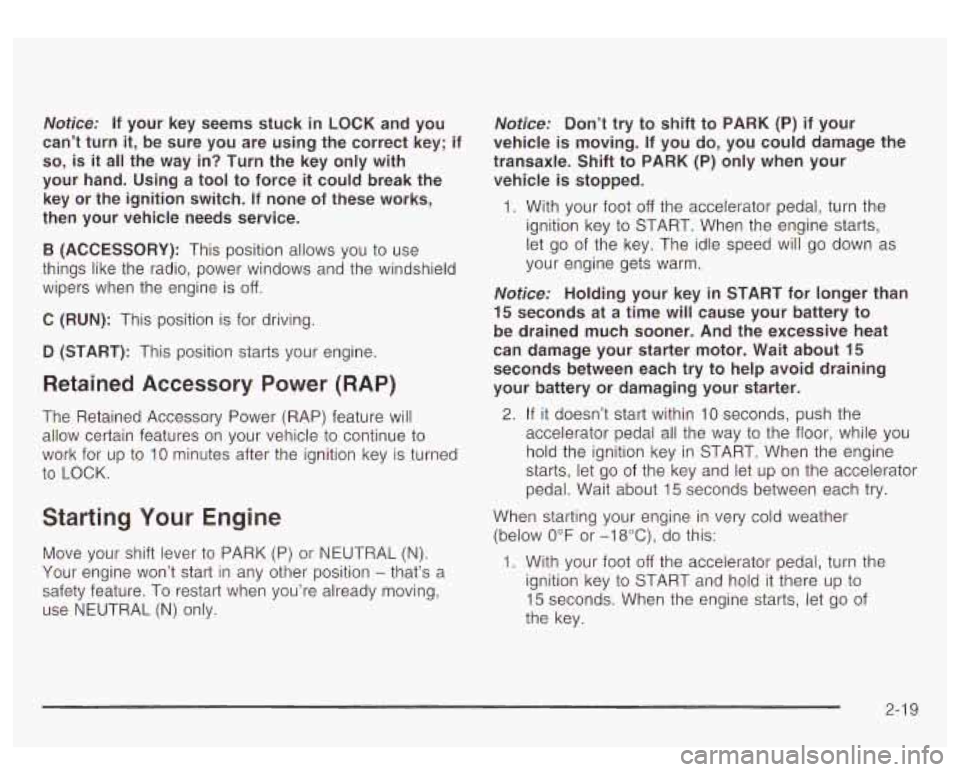
Notice: If your key seems stuck in LOCK and you
can’t turn
it, be sure you are using the correct key; if
so, is it all the way in? Turn the key only with
your hand. Using a tool to force
it could break the
key or the ignition switch.
If none of these works,
then your vehicle needs service.
B (ACCESSORY): This position allows you to use
things like the radio, power windows and the windshield
wipers when the engine is
off.
C (RUN): This position is for driving.
D (START): This position starts your engine.
Retained Accessory Power (RAP)
The Retained Accessory Power (RAP) feature will
allow certain features on your vehicle
to continue to
work for up
to 10 minutes after the ignition key is turned
to LOCK.
Starting Your Engine
Move your shift lever to PARK (P) or NEUTRAL (N).
Your engine won’t start in any other position - that’s a
safety feature. To restart when you’re already moving,
use NEUTRAL
(N) only.
Notice: Don’t try to shift to PARK (P) if your
vehicle
is moving. If you do, you could damage the
transaxle. Shift
to PARK (P) only when your
vehicle
is stopped.
1. With your foot
off the accelerator pedal, turn the
ignition key
to START. When the engine starts,
let go of the key. The idle speed will go down as
your engine gets warm.
Notice: Holding your key in START for longer than
15 seconds at a time will cause your battery to
be drained much sooner. And the excessive heat
can damage your starter motor. Wait about
15
seconds between each try to help avoid draining
your battery or damaging your starter.
2. If it doesn’t start within 10 seconds, push the
accelerator pedal all the way
to the floor, while you
hold the ignition key in START. When the engine
starts, let go of the key and let up on the accelerator
pedal. Wait about
15 seconds between each try.
When starting your engine in very cold weather
(below
0°F or -18”C), do this:
1. With your foot off the accelerator pedal, turn the
ignition key to START and hold it there up
to
15 seconds. When the engine starts, let go of
the key.
2-1 5
Page 134 of 447
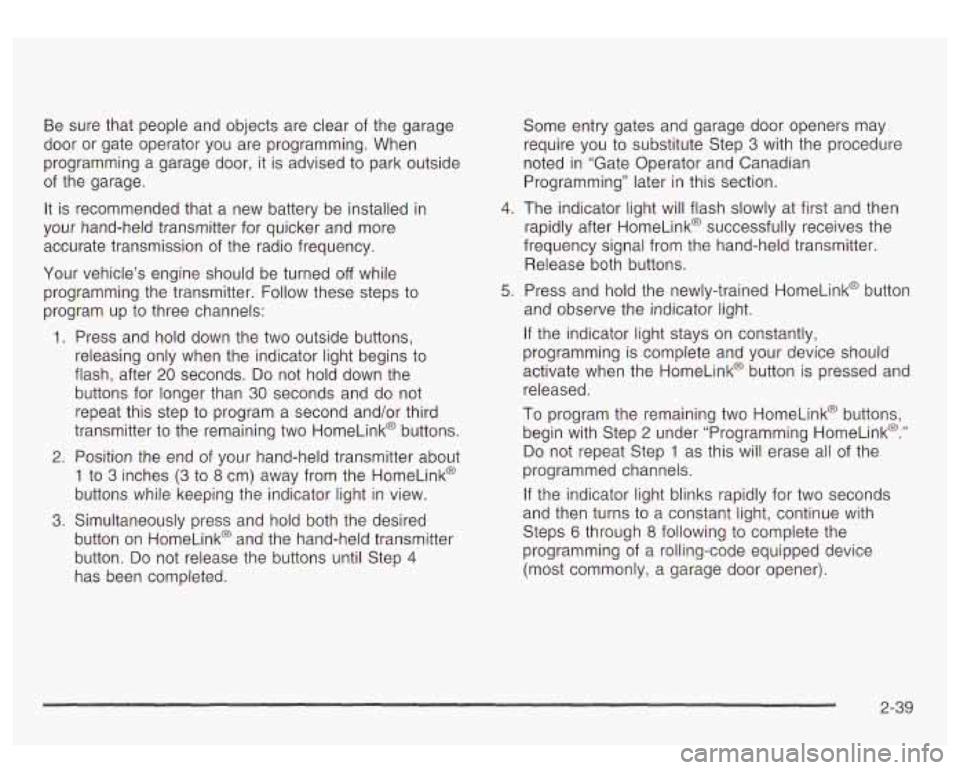
Be sure that people and objects are clear of the garage
door
or gate operator you are programming. When
programming a garage door, it is advised
to park outside
of the garage.
It is recommended that a new battery be installed ip
your hand-held transmitter for quicker and more
accurate transmission of the radio frequency.
Your vehicle’s engine should be turned
off while
programming the transmitter. Follow these steps
to
program up to three channels:
1. Press and hold down the two outside buttons,
releasing only when the indicator light begins
to
flash, after 20 seconds. Do not hold down the
buttons for longer than
30 seconds and do not
repeat this step to program a second and/or third
transmitter
to the remaining two HomeLink@ buttons.
2. Position the end of your hand-held transmitter about
1 to 3 inches (3 to 8 cm) away from the HomeLink@
buttons while keeping the indicator light in view.
3. Simultaneously press and hold both the desired
button on HomeLink@ and the hand-held transmitter
button. Do not release the buttons until Step
4
has been completed. Some entry gates
and garage door openers may
require you
to substitute Step 3 with the procedure
noted
in “Gate Operator and Canadian
Programming” later in this section.
4. The indicator light will flash slowly at first and then
rapidly after HomeLink@ successfully receives the
frequency signal from the hand-held transmitter.
Release both buttons.
5. Press and hold the newly-trained HomeLink@ button
and observe the indicator light.
If the indicator light stays on constantly,
programming
is complete and your device should
activate when the HomeLink@ button is pressed and
released.
To program the remaining two HomeLink@ buttons,
begin with Step
2 under “Programming HomeLink@.”
Do not repeat Step 1 as this will erase all of the
programmed channels.
If the indicator light blinks rapidly for two seconds
and then turns to a constant light, continue with
Steps
6 through 8 following to complete the
programming of a rolling-code equipped device
(most commonly, a garage door opener).
2-39
Page 135 of 447
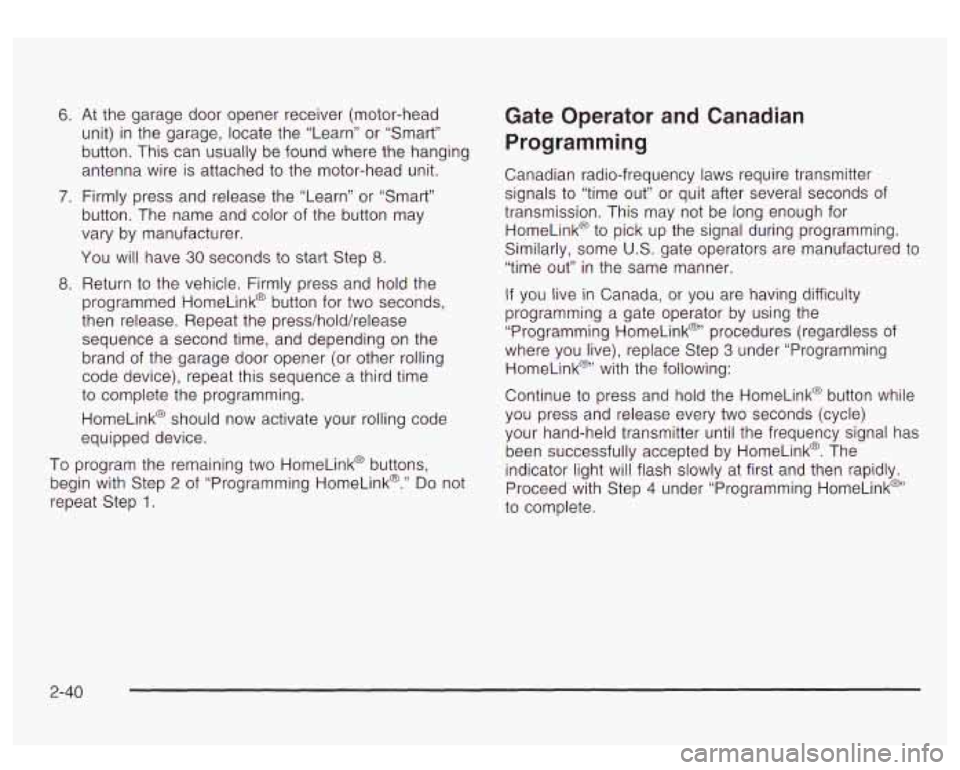
6.
7.
8.
At the garage door opener receiver (motor-head
unit) in the garage, locate the “Learn” or “Smart”
button. This can usually be found where the hanging
antenna wire is attached
to the motor-head unit.
Firmly press and release the “Learn” or “Smart”
button. The name and color of the button may
vary by manufacturer.
You will have
30 seconds to start Step 8.
Return to the vehicle. Firmly press and hold the
programmed HomeLink@ button for two seconds,
then release. Repeat the press/hold/release
sequence a second time, and depending on the
brand of the garage door opener (or other rolling
code device), repeat this sequence a third time
to complete the programming.
HomeLink@ should now activate your rolling code
equipped device.
To program the remaining two HomeLink@ buttons,
begin with Step
2 of “Programming HomeLink@.” Do not
repeat Step
1.
Gate Operator and Canadian
Programming
Canadian radio-frequency laws require transmitter
signals
to “time out” or quit after several seconds of
transmission. This may not be long enough for
HomeLink@’
to pick up the signal during programming.
Similarly, some U.S. gate operators are manufactured
to
“time out” in the same manner.
If you live in Canada, or you are having difficulty
programming a gate operator by using the
“Programming HomeLink@“ procedures (regardless of
where you live), replace Step
3 under “Programming
HomeLink@’ with the following:
Continue to press and hold the HomeLink@ button while
you press and release every two seconds (cycle)
your hand-held transmitter until the frequency signal
has
been successfully accepted by HomeLink@. The
indicator light will flash slowly at first and then rapidly.
Proceed with Step
4 under “Programming HomeLink@”
to complete.
2-40
Page 142 of 447
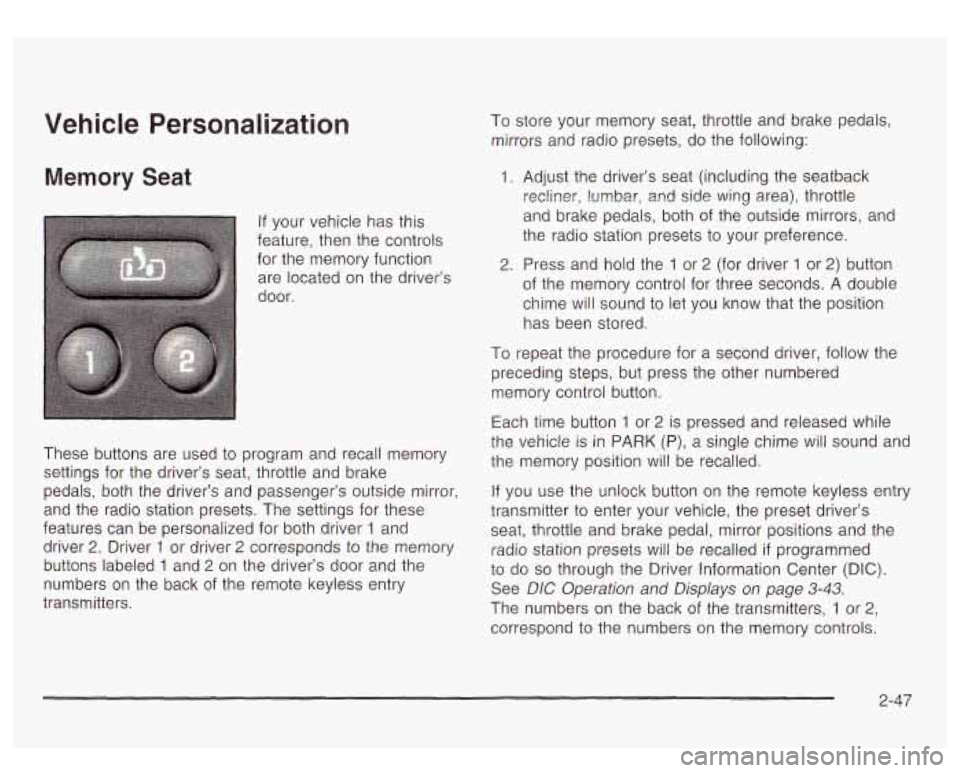
Vehicle Personalization
Memory Seat
If your vehicle has this
feature, then the controls
for the memory function
are located on the driver’s
door.
These buttons are used
to program and recall memory
settings for the driver’s seat, throttle and brake
pedals, both the driver’s and passenger’s outside mirror,
and the radio station presets. The settings for these
features can be personalized for both driver
1 and
driver
2. Driver 1 or driver 2 corresponds to the memory
buttons labeled
1 and 2 on the driver’s door and the
numbers on the back of the remote keyless entry
transmitters. To store your memory seat, throttle and brake pedals,
mirrors and radio presets, do the following:
1. Adjust the driver’s seat (including the seatback
recliner, lumbar,
and side wing area), throttle
and brake pedals, both of the outside mirrors, and
the radio station presets to your preference.
2. Press and hold the 1 or 2 (for driver 1 or 2) button
of the memory control for three seconds. A double
chime will sound
to let you know that the position
has been stored.
To repeat the procedure for a second driver, follow the
preceding steps, but press the other numbered
memory control button.
Each time button
1 or 2 is pressed and released while
the vehicle
is in PARK (P), a single chime will sound and
the memory position will be recalled.
If you use the unlock button on the remote keyless entry
transmitter to enter your vehicle, the preset driver’s
seat, throttle and brake pedal, mirror positions and the
radio station presets will be recalled
if programmed
to do so through the Driver Information Center (DIC).
See DIC Operation and Displays on page
3-43.
The numbers on the back of the transmitters, 1 or 2,
correspond to the numbers on the memory controls.
2-47
Page 145 of 447
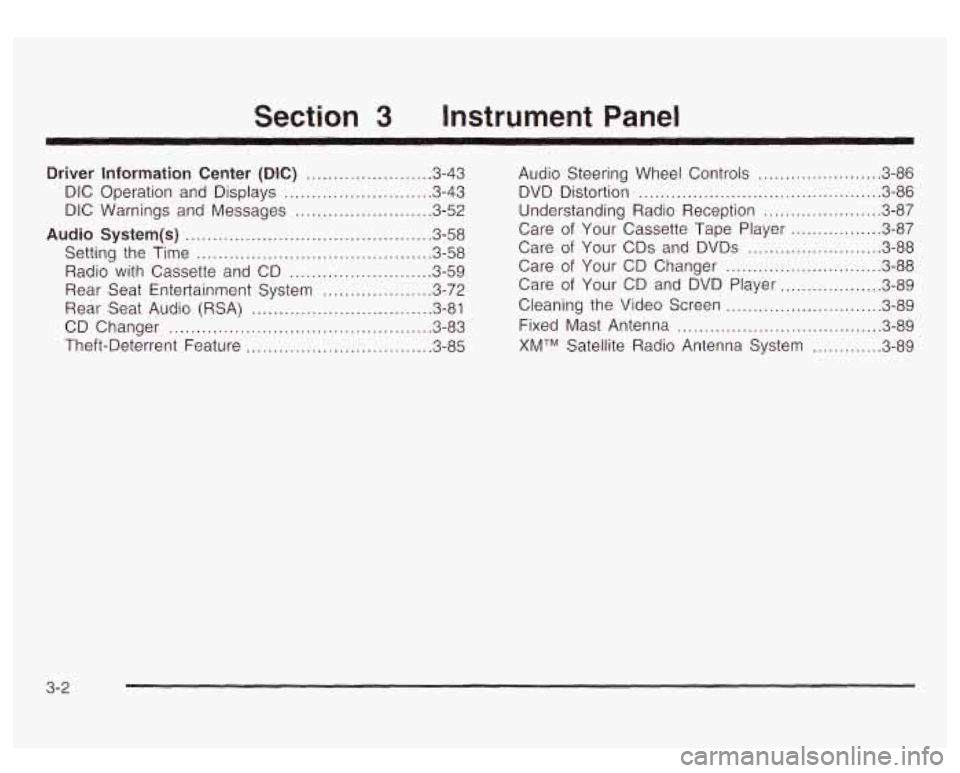
Section 3 Instrument Panel
Driver Information Center (DIC) ................... 3.43
DIC Operation and Displays
....................... 3.43
DIC Warnings and Messages
..................... 3.52
Audio
System(s) ............................................. 3.58
Setting the Time
........................................... 3.58
Radio with Cassette and CD
.......................... 3-59
Rear Seat Entertainment System
.................... 3-72
Rear Seat Audio (RSA)
................................. 3.81
CD Changer
................................................ 3.83
Theft-Deterrent Feature
.................................. 3-85
~ ~~ ~~~
Audio Steering Wheel Controls ........ ....... 3.86
DVD Distortion
............................................. 3.86
Understanding Radio Reception
...................... 3.87
Care
of Your CDs and DVDs ......................... 3-88
Care
of Your
Cassette Tape Player ................. 3-87
Care
of Your CD Changer ............................. 3-88
Care
of Your CD and DVD Player ................... 3-89
Cleaning the Video Screen
............................. 3-89
Fixed Mast Antenna
.................................. 3-89
XMTM Satellite Radio Antenna System ......... 3-89
3-2
Page 148 of 447

The main components of your instrument panel
are the following:
A. Air Outlets
€3. Exterior Lamps Contro!
C. Turn SignaVMultifunction Lever
D. Onstar@ and Radio Steering Wheel Buttons
E. Instrument Panel Cluster
F. Shift Lever/Tow/Haul Selector Button
G. Audio System
H. Dome Override Button
I. Rear Wiper Washer
J. Fog Lamps Button
K. Driver Information Center (DIC) Buttons
L. Parking Brake Release
M. Tilt Lever
N. Comfort Control System
0. Storage Area
P. Compact Disc Changer
Q. Accessory Power Outlet
R. StabiliTrak@ Button
S. Glove Box
Hazard Warning Flashers
Your hazard warning flashers let you warn others. They
also let police know you have a problem, Your front
and rear turn signal
lamps will flash on and off.
But they won’t flash if you’re braking.
3-5
Page 157 of 447
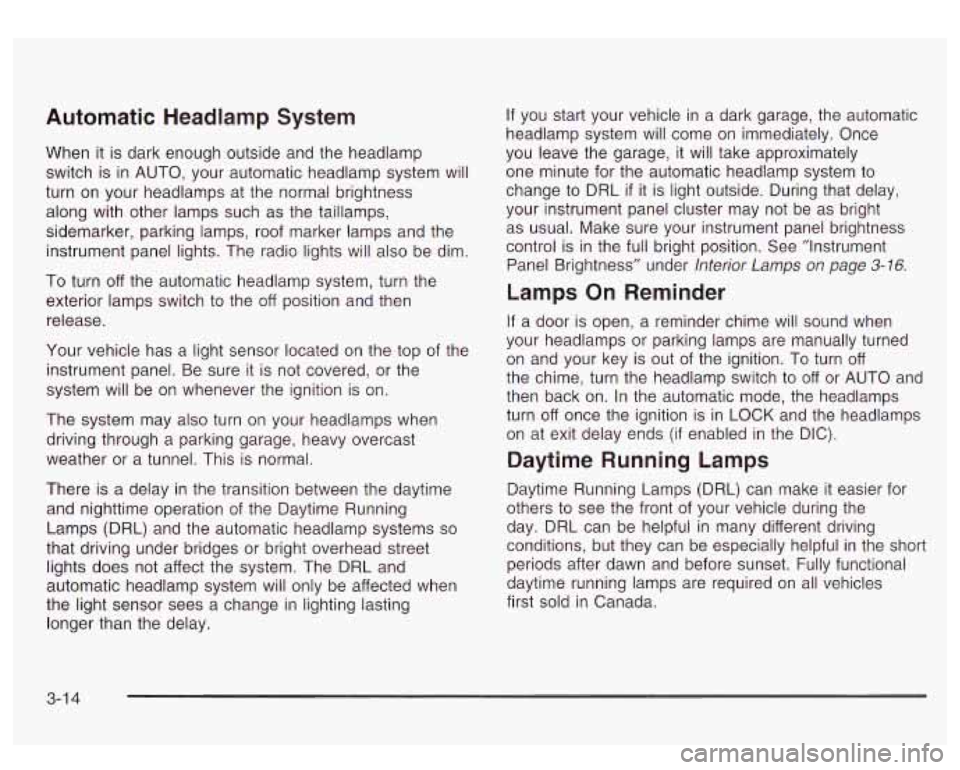
Automatic Headlamp System
When it is dark enough outside and the headlamp
switch is in AUTO, your automatic headlamp system will
turn on your headlamps at the normal brightness
along with other lamps such as the taillamps,
sidemarker, parking lamps, roof marker lamps and the
instrument panel lights. The radio lights will also be dim.
To turn off the automatic headlamp system, turn the
exterior lamps switch
to the off position and then
release.
Your vehicle has a light sensor located on the top of the
instrument panel. Be sure
it is not covered, or the
system will be on whenever the ignition is on.
The system may also turn on your headlamps when
driving through a parking garage, heavy overcast
weather or a tunnel. This is normal.
There is a delay in the transition between the daytime
and nighttime operation of the Daytime Running
Lamps (DRL) and the automatic headlamp systems
so
that driving under bridges or bright overhead street
lights does not affect the system. The DRL and
automatic headlamp system will only be affected when
the light sensor sees a change in lighting lasting
longer than the delay. If
you start your vehicle in a dark garage, the automatic
headlamp system will come on immediately. Once
you leave the garage,
it will take approximately
one minute for the automatic headlamp system to
change
to DRL if it is light outside. During that delay,
your instrument panel cluster may not be as bright
as usual. Make sure your instrument panel brightness
control is in the full bright position. See ”Instrument
Panel Brightness” under lnterior
Lamps on page 3-76.
Lamps On Reminder
If a door is open, a reminder chime will sound when
your headlamps or parking lamps are manually turned
on and your key is out of the ignition. To turn off
the chime, turn the headlamp switch
to off or AUTO and
then back on. In the automatic mode, the headlamps
turn off once the ignition is in LOCK and the headlamps
on at exit delay ends
(if enabled in the DIC).
Daytime Running Lamps
Daytime Running Lamps (DRL) can make it easier for
others
to see the front of your vehicle during the
day. DRL can be helpful in many different driving
conditions, but they can be especially helpful in the short
periods after dawn and before sunset. Fully functional
daytime running lamps are required on all vehicles
first sold in Canada.
3-1 4
Page 159 of 447

The fog lamps will be cancelled after the ignition is
turned
off. If you still want to use the fog lamps after you
restart the vehicle, you will need
to press the fog
lamp button again.
Interior Lamps
Instrument Panel Brightness
The thumbwheel for this feature is located next to the
exterior lamps control.
G:~ (Instrument Panel Lights): Turn the thumbwheel,
located next
to the exterior lamps control, up or
down to brighten or dim the instrument panel lights and
the radio display. This will only work
if the headlamps
or parking lamps are on.
To turn on the dome lamps, with the vehicle doors
closed, turn the thumbwheel all the way up.
Dome Lamps
The dome lamps will come on when you open a door
and will slowly dim
to off when all doors are closed.
You can also turn the dome lamps on by turning
the thumbwheel, located next to the exterior lamp
control, all the way up. In this position, the dome lamps
will remain on whether a door is opened or closed.
(Dome Override): Press this button, located below
the exterior lamp control,
to set the dome lamps to
come on automatically when a door is opened, or remain
off. To turn the lamps off, press the button into the in
position. With the button in this position, the dome lamps
will remain
off when the doors are open. To return the
lamps
to automatic operation, press the button again
and return it
to the out position. With the button in this
position, the dome lamps will come on when you
open a door.
Entry Lighting
Your vehicle is equipped with an illuminated entry
feature.
When a door is opened, the dome lamps and puddle
lamps will come
on if the dome override button is in the
out position. If the dome override button is pressed
in, the lamps will not come on.
Exit Lighting
With exit lighting, the interior lamps will come on when
you remove the key from the ignition. The lamps
will not come on
if the dome override button is
pressed in.
3-1 6
Page 160 of 447
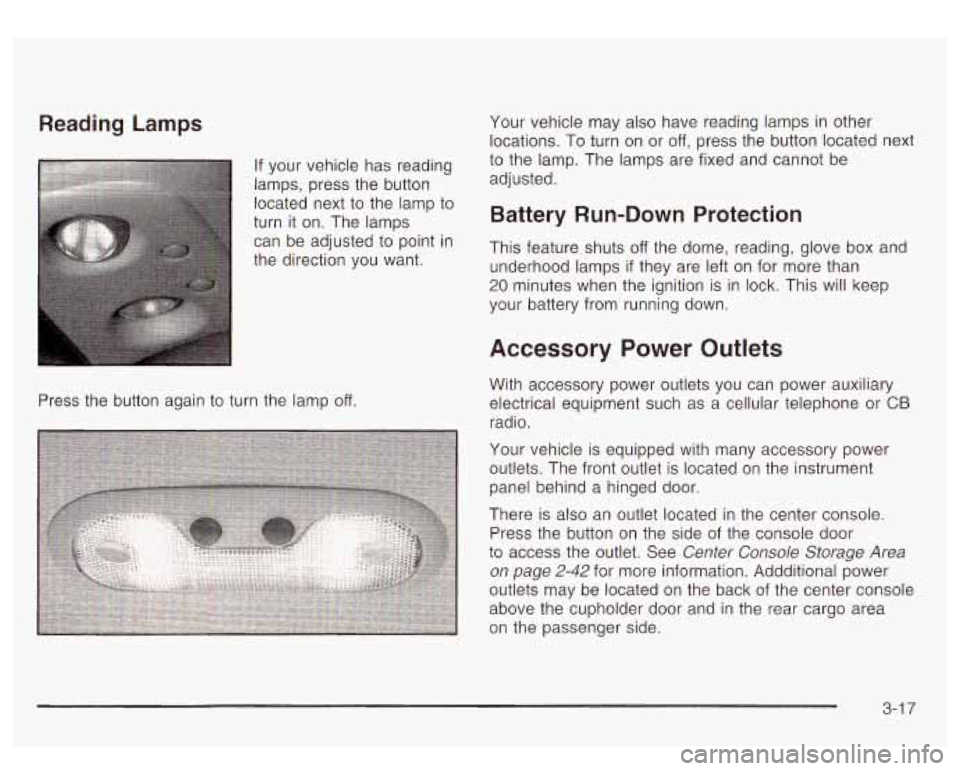
Reading Lamps
If your vehicle has reading
lamps, press the button located next
to the lamp to
turn it on. The lamps can be adjusted
to point in
the direction you want.
Press the button again to turn the lamp
off.
Your vehicle may also have reading lamps in other
locations.
To turn on or off, press the button located next
to the lamp. The lamps are fixed and cannot be
adjusted.
Battery Run-Down Protection
This feature shuts off the dome, reading, glove box and
underhood lamps
if they are left on for more than
20 minutes when the ignition is in lock. This will keep
your battery from running down.
Accessory Power Outlets
With accessory power outlets you can power auxiliary
electrical equipment such as a cellular telephone or
CB
radio.
Your vehicle is equipped with many accessory power
outlets. The front outlet is located on the instrument
panel behind a hinged door.
There is also an outlet located in the center console.
Press the button on the side of the console door
to access the outlet. See Center Console Storage Area
on page 2-42 for more information. Addditional power
outlets may be located on the back of the center console
above the cupholder door and in the rear cargo area
on the passenger side.
3-1 7